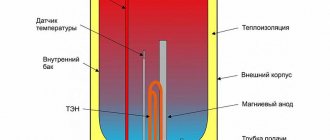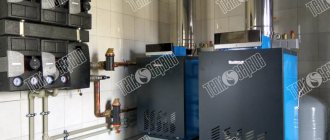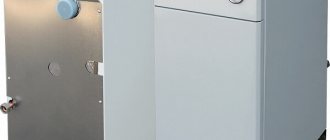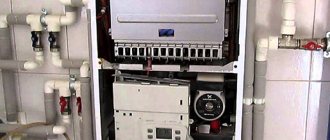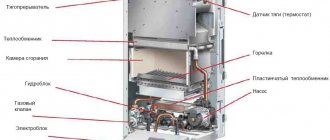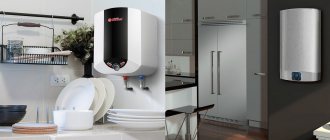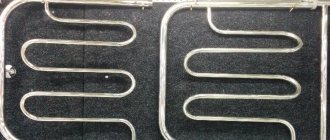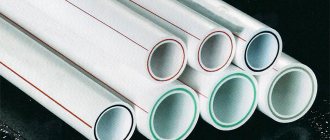What indicators are considered below normal?
Indicators from 1.5 to 2.5 bar are considered optimal.
Most modern boilers operate at a pressure of 1 bar. But even this figure is already below the norm. The lowest limit at which the equipment will operate normally is 1.2-1.3 bar.
But this is only on a cooled system.
The fact is that when heated, the pressure increases. Therefore, you should not try to keep the indicators strictly at 1.5 bar. But you still need to monitor your blood pressure. If it drops below normal, the boiler will simply stop working.
User manual
Control Panel
A user manual is supplied with the unit. The document contains the basic rules for operating the boiler:
- If there is a burning smell in the room, do not turn on the lights, smoke, or use the phone. The device is immediately turned off from the network, and the boiler room is ventilated.
- There must be a place for servicing next to the device. A gap of 30 cm is needed above and below the structure. 10 cm remains on the side and 60 cm near the front.
- When leaving for a long time, the valves for heating, hot water supply and gas supply are closed.
- The recommended coolant pressure is from 1 to 2 bar.
- Explosive and flammable substances and paint and varnish products must not be stored near the boiler.
- To select the heating mode, press MODE. To go to “Summer” use the same button twice, to “Vacation” – three times.
- Water temperature parameters are adjusted using the plus and minus keys.
- To set the temperature indicator of the heating main, you will need to press MODE, and then “plus” or “minus”.
Why does the fall occur - reasons
Sometimes it happens that the pressure constantly drops. Of course, you can ignore it and just feed the system occasionally. But these are short-term measures. It is better to determine the cause, since the consequences of low pressure can be disastrous.
Important! It is not necessary to contact specialists. Most of the reasons are easy to identify and eliminate on your own.
A leak
A leak is an unplanned decrease in the volume of coolant. This usually happens because the joints are not tight enough or welded incorrectly.
Sometimes a leak can be detected visually. It is enough to look at all the connections in the heating. If everything looks normal, you will have to turn off the heating and check differently.
To do this you will need:
- Turn off the boiler.
- Wait until the system cools down completely.
- Turn off the taps on the radiators.
- Raise the pressure to 1.5 bar.
- Turn on the boiler.
If there are two heating wings, check one first, then the other. Now all that remains is to monitor the pressure. If it falls, the cause is the boiler or pipes.
If the pressure remains within normal limits, you need to open the taps at each radiator one by one. The reason is one of them.
Attention! Sometimes leakage occurs due to corrosion of the metal when it comes into contact with air. Therefore, it is not recommended to drain water from heating in summer.
Water may leak through threaded connections. Then they need to be tightened or the gasket replaced. Sometimes the taps leak.
In this case, you will have to install new ones. If water escapes through welding joints, you can use cold welding. If it is a polypropylene seam, you will have to desolder and resolder the fitting.
Cracks
Nowadays, in most cases, pipes made of polypropylene or cross-linked polyethylene are used for heating.
Metal and metal-plastic pipes are also installed, but much less frequently. Cracks almost never occur on them. But the radiators and heat exchanger in the boiler may crack.
Identifying a crack in a radiator is easy. Water will leak out of it.
Even if there is no puddle underneath, smudges will still appear. If the radiator is sectional, this will not cause any special costs.
Of course, you will have to remove it and unscrew it, but only the broken sections will need to be replaced. If the radiator is a panel one, you will have to replace it completely. Or try brewing it.
Reference! To see the crack in the heat exchanger, you will have to disassemble the boiler. To do this you will need a screwdriver or torx. It all depends on the model.
First you need to remove the front cover. In non-turbocharged boilers, the combustion chamber is open, so it is easier to get to the heat exchanger. But a closed chamber does not cause any particular difficulties.
Now you need to inspect the heat exchanger. Usually, in the place where the crack is located, the metal oxidizes and acquires a greenish tint.
If there is one, then the heat exchanger needs to be changed . Sometimes it is possible to weld a crack using a gas torch , but most models cannot be repaired.
Expansion tank
The reason may also be that the membrane in the tank has broken.
This is especially common in flat expansion tanks , which are installed in wall-mounted boilers.
The fact is that in the summer the membrane sticks to the walls, and when the heating is turned on, it simply breaks. In this case, you will have to change the membrane or the entire tank.
If the pressure rises or falls immediately after starting the heating, this may be due to the incorrect selection of the expansion tank. Its volume should be a tenth of the volume of liters of water in the system. Or one seventh if antifreeze was poured into the pipes.
Open tap
To fill water into the heating, use a make-up tap. It connects the water supply and the boiler. Users often forget to close it, and this is precisely why the pressure may decrease.
Important! If the boiler is double-circuit, it works both for heating and for heating hot water. In this case, the effect of communicating vessels occurs.
When hot water is not used, the pressure is normal. As soon as the mixer is opened, the pressure drops sharply. This happens because water from the heating goes into the water supply.
By the way, this can be understood by the smell that comes from the water supply. Typically, heating water does not smell very pleasant. If the make-up valve is working properly, just close it. If it is broken, you will have to change it.
Proper installation of boilers involves installing ball valves at all outlets and inlets. Therefore, you can simply turn off the water taps when not in use. But this is a short-term solution.
Air in the system
When the system is filled with water, some air may remain in the pipes.
This problem is solved by automatic drains, which are installed at the highest heating points.
Unfortunately, the air is not always removed completely. Much depends on the design of the system. For example, aluminum radiators emit hydrogen. It also comes out through the drains, but it is precisely because of this that the pressure in the system drops.
Over time, this process may slow down or disappear altogether. But at first you will have to put up with the problem. Or replace the radiators with others.
There are other reasons for the appearance of air in the system:
- Incorrect installation.
- Long downtime of heating.
- Water itself releases oxygen.
- Various chemical reactions.
Attention! Practice shows that it is impossible to achieve complete sealing of the system by any means. Air gets into the heating anyway.
Air jams
Most of the air exits through automatic vents. But sometimes the air simply does not reach them, as it remains in one place. This usually happens at the top of radiators.
This is called air locks. A Mayevsky tap must be installed on each radiator. If you open it, air will escape, but in this case the pressure in the system will drop. It should be kept open until water flows.
It also happens that air accumulates in another part of the radiator, where a plug is usually installed instead of the Mayevsky valve.
Of course, you can remove it and install another Mayevsky tap, but it is better to redo the connection. The pipe will enter from above and exit from the other side from below. In this case, air pockets may still appear, but getting rid of them will be much easier.
Faulty valve
In order for the heating system to work properly, the pressure must not be allowed to drop below normal. But the increase is also fraught with unpleasant consequences.
Therefore, a safety valve is used to prevent overpressure. For domestic needs, 3 bars are sufficient.
If the pressure reaches this limit, the valve will open and release excess water.
This technique allows you to avoid breakdown of all weak elements of the system. But sometimes the valve can break.
In this case, it will constantly discharge water, which will lead to a decrease in pressure. It is very easy to determine such a breakdown - there will be a puddle next to the valve. Getting rid of the problem is also easy. You just need to replace the valve.
Faulty pressure gauge
If the system is working normally, but the pressure readings are still below normal, the cause may be a broken pressure gauge. Usually his arrow just stays in one place. Although it also happens that she continues to move. It can be difficult to understand this visually, so the pressure gauge needs to be removed.
Reference! You cannot unscrew the pressure gauge while holding it by the body. For these purposes, use a fitting and a regular wrench.
If the pressure gauge is unscrewed and it continues to show pressure, then it is faulty. They usually have a very thin entrance that can simply become clogged. In some cases it is enough to clean it, but sometimes it is easier to replace it.
Popular modifications
The feature of Proterm equipment is the “animal”, “predatory” name of the series:
- Tiger - dual-circuit devices with an electronic unit.
- Leopard and Lynx – double-circuit type for wall mounting with complete bithermal heat exchangers.
- Panther is a model with two circuits and a closed chamber.
- Bear and Grizzly are units with automatic adjustment.
- Cheetah – equipped with a built-in circulation pump.
- Stingray - with a minimal level of harmful emissions.
- Bison and Beaver are floor options.
Features of the Cheetah line
The Gepard series is suitable for a private house or apartment; it does not take up much space in the boiler room. Several devices are popular among users.
Gepard 11 MTV
Gepard 11 MTV is a model with an atmospheric burner, which is installed in a residential building of up to 100 square meters. Distinctive characteristics:
- supply of 11 liters of water per minute for the hot water system;
- 5 l membrane expansion tank;
- Efficiency is about 90%;
- wall mounting method;
- LCD display with power adjustment;
- presence of a pressure sensor and self-diagnosis system.
Gepard 23 MTV
Gepard 23 MTV is a wall-mounted device with a closed camera. The features of the Proterm Cheetah boiler modification 23 MTV include:
- power indicator of 23.3 kW, which is enough for a house of up to 200 square meters;
- chimneyless type of unit;
- heating water for hot water supply by 38-60 degrees, for heating - by 38-80 degrees;
- connection to a 220 V power supply
- main gas consumption 2.4 m3/h, liquefied gas – 1.02 m3/h;
- The optimal pressure in the hot water supply and the heating circuit is 3 bar.
Gepard 11 MOV
Gepard 11 MOV is a two-circuit unit with a power of 9-11 kW of wall-mounted type. Device specifications:
- open combustion chamber with automatic ignition;
- Efficiency 90.3%;
- pressure in the circuit – 3 bar, in the DHW – 10 bar;
- equipped with a 5 liter expansion tank;
- equipped with monitoring systems for gas pressure, flame attenuation, overheating and water freezing.
An additional external temperature controller can be connected to the boiler.
Gepard 23 MOV is a gas compact boiler manufactured by Protherm series Gepard 23 MOV - wall-mounted. It features an open combustion chamber and accelerated heating of the liquid. Equipment specifications:
- natural draft system;
- power equal to 23 kW;
- two heat exchangers - copper (primary) and stainless steel (secondary);
- burner with self-modulation;
- Efficiency from 90.3 to 93.2%.
Protherm gas units of the Gepard series are distinguished by their build quality and durability. They are suitable for wall mounting in the private sector or apartment in a high-rise building. When choosing equipment, you need to take into account that a two-year warranty is issued only when the boiler is installed by a specialist.
Preventing problems
Instead of solving a problem, it is better to prevent it in advance. And it's not that difficult to do.
You just need to follow certain rules:
- Carry out equipment maintenance once a year.
- Monitor the correct operation of the system.
- Correct faults in a timely manner.
Before each heating season, you should bleed the air from the radiators. It will only take a few minutes, but it will avoid problems in the future.
In addition, the quality of installation has a great influence . For those who are not particularly versed in heating, it is better to contact specialized organizations. Reworking and correcting mistakes later can be difficult.
Equipment and principle of operation of gas boilers Protherm Gepard
Construction of the Cheetah boiler
A standard wall-mounted unit with two circuits is equipped with main components, software and a hydraulic group. The main elements of the boiler include:
- membrane type expansion tank;
- sensor that monitors water parameters in pipes;
- hydraulic mechanisms;
- block with electronic board;
- burner with electric ignition system
- electrode protection;
- boiler;
- turbine for turbocharged models;
- coaxial pipe and distribution adapter.
The hydrogroup is represented by:
- 3 atm safety valve;
- pressure controller;
- plate secondary boiler made of stainless steel;
- automatic air vent;
- valve switchable in 3 positions;
- pump for supplying liquid to the circuit;
- gas valve type SIT.
The system is controlled using an LCD monitor, where the main parameters are displayed. Built-in diagnostics determine the error code. Branded software allows you to operate the thermal power device in the “Eco” (heating the coolant up to 50 degrees) and “Warm Floor” modes.
Principle of operation
A double-circuit device with a turbine can be connected to heating and hot water systems. The water is heated by a plate heat exchanger. Fuel combustion products are discharged through a coaxial chimney. Oxygen is taken for the combustion reaction through forced circulation.
A modulating gas burner allows you to select the flame power when heating water and coolant. When the hot liquid valve opens, the power indicator increases and the mode switches. The operating parameters are set by the user. In the future, they can be changed automatically or adjusted mechanically.
